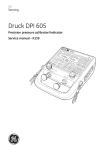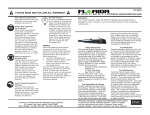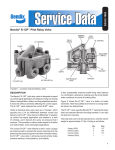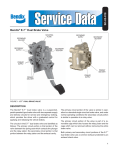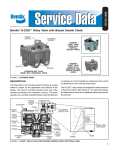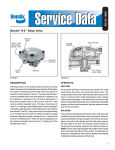Download BENDIX BW1660 User's Manual
Transcript
SD-03-1061A ® Bendix® R-8P™ Pressure Equalizing Pilot Relay Valve SPRING COVER PISTON PISTON ORIFICE VENT SERVICE (CONTROL) PORT BODY DELIVERY PORTS INLET/EXHAUST VALVE ASSEMBLY EXHAUST SUPPLY PORT DELIVERY PORT SUPPLY PORT FIGURE 1 - CUTAWAY AND EXTERNAL VIEW DESCRIPTION OPERATION The R-8P™ pressure equalizing pilot relay valve is a device designed to reinforce the control signal on long wheel base towing trailers and converter dollies. APPLICATIONS (FIG. 2) Unlike a standard relay valve which typically has a 4 p.s.i. crack pressure and similar differential between control and delivery, the R-8P™ valve has a 0 p.s.i. differential. On the converter dolly and long wheel base towing trailers, the R-8P™ valve reinforces the service brake application signal without the differential found in standard relay valves. The 0 p.s.i. differential of the R-8P™ valve assures that all trailer and dolly brakes will receive the same strength control signal even during light brake applications. By providing a balanced pressure signal to all trailer and dolly brakes, the R-8P™ valve helps achieve overall vehicle brake balance and stability. The R-8P™ valve also helps improve brake lining wear balance on combination vehicles by causing even the most distant brake to contribute its share of braking effort. When a service brake application is made, air delivered from the brake valve enters the service port of the R-8P™ valve. As air pressure fills the space above the piston, it begins to force the piston down. Because of the spring force above the piston, the piston exhaust seat is already in contact with the inlet/exhaust valve, sealing off the exhaust. As the piston begins to move downward it forces the inlet/exhaust valve off the inlet seat, allowing air from the reservoir to be delivered out the delivery ports of the R-8P™ valve in direct proportion to the pressure received at the service port. Any differential between service and delivery pressure caused by friction or resistance to the movement of the piston (commonly called crack pressure and normally in the range of 2 to 4 p.s.i.) is eliminated due to passage of air through the orifice in the piston. 1 R-8P™ VALVE BRAKE VALVE SPRING PISTON ORIFICE PISTON R-8P™ VALVE SPRING PISTON BRAKE VALVE PISTON ORIFICE SERVICE SUPPLY RESERVOIR SERVICE SUPPLY RELAY VALVE INLET/EXHAUST VALVE ASSEMBLY SERVICE BRAKES VENT DELIVERY FIGURE 2 - OPERATIONAL VIEW OF APPLICATION BALANCE (FIG. 3) The air pressure being delivered by the open inlet valve also is effective on the bottom area of the R-8P™ valve relay piston. When air pressure beneath the piston equals the service air pressure on top of the piston, the piston lifts slightly and the inlet/exhaust valve is returned to the inlet seat. The exhaust remains closed as the delivery pressure balances with the service line pressure. Balancing of the pressure above and below the piston through the orifice of the R-8P™ valve piston assures that the service and delivery pressures are equal and 0 p.s.i. differential exists. As delivered air pressure to the R-8P™ valve service port is changed, the valve reacts, holding the desired application pressure. EXHAUST RELAY VALVE PREVENTIVE MAINTENANCE Important: Review the Bendix Warranty Policy before performing any intrusive maintenance procedures. A warranty may be voided if intrusive maintenance is performed during the warranty period. 2 SERVICE BRAKES RESERVOIR INLET/EXHAUST VALVE ASSEMBLY DELIVERY FIGURE 3 - OPERATIONAL VIEW OF BALANCED POSITION R-8P™ VALVE SPRING PISTON BRAKE VALVE PISTON ORIFICE SERVICE SUPPLY EXHAUST EXHAUST OR RELEASE (FIG. 4) When air pressure is released from the service port and air pressure in the cavity above the piston of the R-8P™ valve is exhausted, air pressure beneath the piston lifts it upward, further seating the inlet/exhaust valve against the inlet seat. Raising the exhaust seat of the piston off the inlet/exhaust valve, opens the exhaust. This allows the delivery air pressure to rapidly exhaust to atmosphere. As air pressure under the piston drops, the spring force above the piston will push the piston downward, once again placing the exhaust seat of the piston in contact with the inlet/exhaust valve. Any pressure remaining under the piston will pass through the piston orifice and be exhausted at the brake valve. VENT RESERVOIR INLET/EXHAUST VALVE ASSEMBLY RELAY VALVE SERVICE BRAKES DELIVERY FIGURE 4 - OPERATIONAL VIEW OF RELEASE No two vehicles operate under identical conditions, as a result, maintenance intervals may vary. Experience is a valuable guide in determining the best maintenance interval for air brake system components. At a minimum, the valve should be inspected every 6 months or 1500 operating hours, whichever comes first, for proper operation. Should the valve not meet the elements of the operational tests noted in this document, further investigation and service of the valve may be required. CONTROL TO SECOND TRAILER CONTROL FROM TOWING TRAILER R-8P™ RELAY VALVE SC-1™ SINGLE CHECK VALVE RE-6™ RELAY EMERGENCY VALVE SUPPLY TO SECOND TRAILER SUPPLY FROM TOWING TRAILER SV-1™ SYNCHRO VALVE S = SUPPLY C = CONTROL D = DELIVERY E = EXHAUST EM = EMERGENCY FIGURE 5 - SCHEMATIC OF TYPICAL DOLLY SYSTEM OPERATION AND LEAKAGE TEST 1. Block the wheels and fully charge the air system. Adjust the brakes. 2. Apply and release the service brakes several times and check for prompt response of the brakes at all appropriate wheels. 3. 3. With the air system fully charged, apply a soap solution to the exhaust of the R-8P™ valve. Leakage of a 1" bubble in 5 seconds is permissible. 4. Make and hold a full brake application and again apply a soap solution to the R-8P™ valve exhaust. Leakage of a 1" bubble in 3 seconds is permissible. 5. With the brakes still applied, apply a soap solution around the valve where the cover meets the body. No leakage at this point is permitted. If the valve is unable to pass these operation and leakage tests, repair or replace it with a new or genuine Bendix remanufactured unit, available at any authorized parts outlet. WARNING! PLEASE READ AND FOLLOW THESE INSTRUCTIONS TO AVOID PERSONAL INJURY OR DEATH: 4. 5. 6. 7. When working on or around a vehicle, the following general precautions should be observed at all times. 1. Park the vehicle on a level surface, apply the parking brakes, and always block the wheels. Always wear safety glasses. 2. Stop the engine and remove ignition key when working under or around the vehicle. When working in the engine compartment, the engine 8. should be shut off and the ignition key should be removed. Where circumstances require that the engine be in operation, EXTREME CAUTION should be used to prevent personal injury resulting from contact with moving, rotating, leaking, heated or electrically charged components. Do not attempt to install, remove, disassemble or assemble a component until you have read and thoroughly understand the recommended procedures. Use only the proper tools and observe all precautions pertaining to use of those tools. If the work is being performed on the vehicle’s air brake system, or any auxiliary pressurized air systems, make certain to drain the air pressure from all reservoirs before beginning ANY work on the vehicle. If the vehicle is equipped with an AD-IS™ air dryer system or a dryer reservoir module, be sure to drain the purge reservoir. Following the vehicle manufacturer’s recommended procedures, deactivate the electrical system in a manner that safely removes all electrical power from the vehicle. Never exceed manufacturer’s recommended pressures. Never connect or disconnect a hose or line containing pressure; it may whip. Never remove a component or plug unless you are certain all system pressure has been depleted. Use only genuine Bendix ® replacement parts, components and kits. Replacement hardware, tubing, hose, fittings, etc. must be of equivalent size, type and strength as original equipment and be designed specifically for such applications and systems. 3 6 1 PISTON ORIFICE 9 8 2 SERVICE (CONTROL) PORT 3 VENT SUPPLY PORT 7 4 10 5 11 12 DELIVERY PORTS EXHAUST FIGURE 6 - CUTAWAY 9. Components with stripped threads or damaged parts should be replaced rather than repaired. Do not attempt repairs requiring machining or welding unless specifically stated and approved by the vehicle and component manufacturer. 10. Prior to returning the vehicle to service, make certain all components and systems are restored to their proper operating condition. REMOVAL 1. Block or hold the vehicle by means other than the brakes. 2. Drain all air brake system reservoirs. 3. Identify, mark and disconnect all air lines from the R-8P™ pilot relay valve. 4. Remove the R-8P™ valve from its mount on the vehicle. DISASSEMBLY OF VALVE (REFER TO FIG. 6) 1. Note and mark position of valve cover (6) to body (7). 2. Remove four 5/16"-18 hex screws and separate the cover from the body (7). 3. Remove and discard sealing ring (3) from body (7). 4. Remove piston (8) and spring (9) from cover (6) and retain all parts. ASSEMBLY (REFER TO FIG. 6) NOTE: Make certain both piston orifices are open and not clogged. Grease all o-rings, o-ring grooves and bores with a barium base lubricant. 1. Install diaphragm (5) and diaphragm washer (12) and secure with screw (11). Torque screw to 15-25 inch pounds. 2. Install inlet and exhaust valve assembly (4) in valve body (7). Position exhaust cover assembly (10) so that all holes are properly aligned and secure with four 10-24 screws. Torque screw to 20-30 inch pounds. 3. Install sealing ring (3) in valve body (7). 4. Install o-rings (1 and 2) on the piston (8). 5. Install spring (9) in valve cover (6) so that the large diameter end of the spring will rest on the piston. 6. Install piston (8) (with its o-rings installed) in valve cover (6). Note: Make certain spring (9) is centered and not binding. 7. Install valve cover (6) on valve body (7) in same position as marked in Step 1 of “Disassembly”. Secure the cover to the body using four 5/16" hex head cap screws. Torque to 120-150 inch pounds. 5. Remove and discard o-ring (2) from piston (8). INSTALLATION 6. Remove screw (11), washer (12) and diaphragm (5) from exhaust cover (10). Discard diaphragm (5). 1. Mount the R-8P™ valve to the vehicle using new bolts or other hardware. 7. Remove four 10-24 screws which secure exhaust cover (10) to body (7). 2. Connect air lines to the R-8P™ valve using identification made during Step 3 of “Removal” instructions. 8. Remove and discard inlet exhaust assembly (4) from body (7). 3. Perform “Operation and Leakage Checks” before placing vehicle in service. 9. Clean all remaining parts in a cleaning solvent equivalent to mineral spirits. Make certain all surfaces, bores and passages are clean and dry. 4 BW1660 © 2004 Bendix Commercial Vehicle Systems LLC. All rights reserved. 3/2004 Printed in U.S.A.






